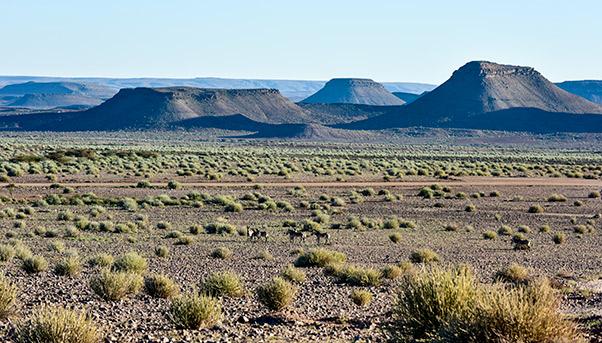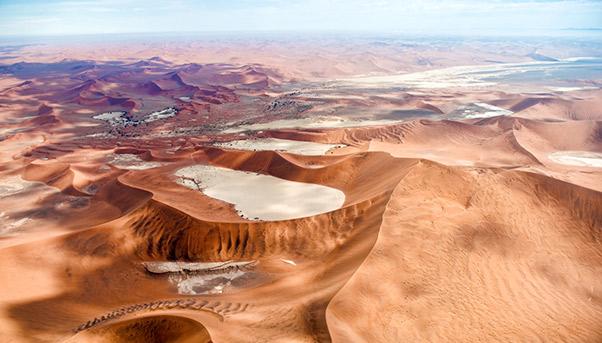
In the southernmost region of Namibia, cranes, trucks and tractors are swerving, rumbling and ploughing to make a desert bloom.They are part of a project to build a dam that will capture the waters of a river and use it to irrigate the surrounding land to grow fruit. Part of the government’s Green Scheme Policy, the Neckartal Dam project promises to create hundreds of jobs and generate millions of Namibian dollars for the economy of the Karas region and the country at large.
In a budget statement made in 2013 when work on the dam was just getting started, then-Finance Minister Saara Kuugongelwa-Amadhila highlighted the importance of the project and how it exemplified the government’s efforts to improve the quality of life of its citizens. “Provision of bulk and potable water remains a core priority to ensure adequate supplies for households and industry,” she said. “(One of the) major projects envisaged (is) the construction of Neckartal Dam.”
Largest Dam
Once completed, Neckartal will be the largest water storage dam in Namibia, three times the size of the Hardap Dam, which currently holds the record in the region of the same name just north of Karas.
First conceived by German colonisers more than 100 years ago, the idea of a dam on the Fish River near the city of Keetmanshoop did not come to fruition until Namibia won independence from South Africa in 1990. It then took more than two decades before a tender to build it was held.
Having completed the excavation of some 800,000 cubic metres of earth and rock on the river bed and the construction of abutments on either side of it, workers have been building the foundation of the dam, one layer of concrete at a time with the use of earth-moving equipment. This method is called roller-compacted concrete (RCC),
which is faster and economically advantageous in respect to other methods. The construction of the dam requires the diversion of the river in two phases. Phase I involves the construction of a temporary enclosure called a cofferdam on the left side of the river. Standing at a height of 10 metres, it will allow workers to complete the excavations in safety, prepare the foundations of the dam, start pouring the reinforced concrete and build a diversion culvert, which allows water to flow under its structure. Phase II will see the deviation of the river through this diversion culvert so as to allow workers to complete the job on the right side of the riverbed.
With a future height of about 80 metres and a crest length of 518 metres, Neckartal will be a curved gravity dam. It will have an intake tower housing pipes, valves and gates to bring the water captured by the future reservoir to a chamber with two 1.5-megawatt Francis turbines.
Deepest of blue
Karas being a dry region, Eric Britton, the project’s resident engineer, expects it to take two years to fill up the reservoir once the dam is complete. He bases his calculation on an estimated average run-off of 500 million cubic metres of water a year. Given the scarce rainfall in the region, the river only flows between January and May.

The future reservoir will have a holding capacity of 880 million cubic metres of water, the equivalent of 300,000 Olympic pools. Its surface area will cover nearly 40 square kilometres. In describing the project to Namibian President Hage G. Geingob during an official visit to the site in October 2015, Britton said the color of the water in the reservoir would be the deepest of blue. “It will be beautiful.” Neckartal will take water from the reservoir to produce energy with its Francis turbines for a pumping station at an abstraction weir – an obstruction that allows some water to flow over it – located 13 kilometres downstream. Running 360 metres in length and 9 metres in height, the weir will capture the water sent by the pumping station and send it another 10 kilometres along a steel pipe to a holding dam with a reservoir with a capacity of 90,000 cubic metres. From there, the water will be directed to an irrigation system covering 5,000 hectares.
Employment for hundreds
The project is far from being complete by Italy’s Salini Impregilo but it has already made itself felt in the region by creating hundreds of jobs for the locals. Of the 760-odd people who work on site, 67% of them are from Karas. Only 8% are foreigners. Then there are the subcontractors. So the total number of people working at the project has arrived at about 1,500 people. This is significant for a region where unemployment among people of working age is 32.2% or 12,838, according to Namibia Statistics Agency figures, which are based on a 2011 census.
Once Neckartal is complete and water starts to flow through the irrigation system, Britton expects the plantations will employ hundreds of people. With 5,000 hectares of land to be irrigated for fruit cultivation, Britton estimates that revenue and other spin-offs could amount to hundreds of millions of Namibia dollars. The land will be located to the north and south of Keetmanshoop, the biggest city in the region some 40 kilometres west of the construction site. Agriculture, along with forestry and fishing, is the main industry in Karas, employing 32.4% of the working population.

